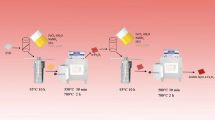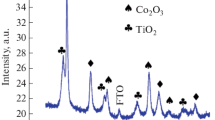Abstract
Herein, the Ti/Co3O4 electrodes with n-type semiconductor characteristics were fabricated by a typical hydrothermal process using F− ion as dopant, and their morphology control was also performed by tailoring the hydrothermal temperature. The F− doped Ti/Co3O4 electrodes could be used as photoanode to degrade anthraquinone dye (reactive Brilliant Blue KN-R), and showed excellent photoelectrocatalytic (PEC) activity. It is proposed that the fast ions and electron transportation, high oxygen evolution potential, lower resistance, large active area, and good electrolyte infiltration are responsible for the improved PEC activity of the F− doped Ti/Co3O4 system. Nevertheless, the F− doped Ti/Co3O4 electrode with divergent flower-like structure composed of needle nanowires exhibited highest PEC activity than that of other electrodes. It is noteworthy that the presence of electrostatic anti-barrier arises from an “ohmic” contact between the metal (Ti) and the semiconductor (Co3O4) is also an important factor for the higher PEC activity of the F− doped Ti/Co3O4 electrodes. The work provides unique insight into the design of Co3O4 photoanode from a perspective of tailoring the ion doping and morphology.









Similar content being viewed by others
References
Wang L, Ke F, Zhu J (2016) Metal-organic gel templated synthesis of magnetic porous carbon for highly efficient removal of organic dyes. Dalton Trans 45(11):4541–4547
Martinez-Huitle CA, Ferro S (2006) Electrochemical oxidation of organic pollutants for the wastewater treatment: direct and indirect processes. Chem Soc Rev 35(12):1324–1340
Korbahti BK, Tanyolac A (2008) Electrochemical treatment of simulated textile wastewater with industrial components and Levafix Blue CA reactive dye: optimization through response surface methodology. J Hazard Mater 151(2-3):422–431
Barredo-Damas S, Iborra-Clar MI, Bes-Pia A, Alcaina-Miranda MI, Mendoza-Roca JA, Iborra-Clar A (2005) Study of preozonation influence on the physical-chemical treatment of textile wastewater. Desalination 182(1-3):267–274
Feng Y, Yang L, Liu J, Logan BE (2016) Electrochemical technologies for wastewater treatment and resource reclamation. Environ Sci: Wat Res Technol 2:800–831
Moussavi G, Mahmoudi M (2009) Removal of azo and anthraquinone reactive dyes from industrial wastewaters using MgO nanoparticles. J Hazard Mater 168(2-3):806–812
Gong D, Zhu J, Lu B (2016) RuO2@Co3O4 heterogeneous nanofibers: a high-performance electrode material for supercapacitors. RSC Adv 6(54):49173–49178
He ZQ, Huang CX, Wang Q, Jiang Z, Chen JM, Song S (2011) Preparation of a praseodymium modified Ti/SnO2-Sb/PbO2 electrode and its application in the anodic degradation of the A1zo dye acid black 194. Environ Sci: Wat Res Technol 6:4341–4354
Polcaro AM, Palmas S, Renoldi F, Mascia M (1999) On the performance of Ti/SnO2 and Ti/PbO2 anodes in electrochemical degradation of 2-chlorophenol for wastewater treatment. J Appl Electrochem 29(2):147–151
Dai Q, Shen H, Xia Y, Chen F, Wang J, Chen J (2013) The application of a novel Ti/SnO2–Sb2O3/PTFE-La-Ce-β-PbO2 anode on the degradation of cationic gold yellow X-GL in sono-electrochemical oxidation system. Sep Purif Technol 104:9–16
Haidar M, Dirany A, Sires I, Oturan N, Oturan MA (2013) Electrochemical degradation of the antibiotic sulfachloropyridazine by hydroxyl radicals generated at a BDD anode. Chemosphere 91(9):1304–1309
Dan YY, Zhang L, Chen LZ, Yue HJ, Lin HB, Lu HY (2014) Preparation of PbO2/nano-WO3 composite electrodeposition Ti substrate by composite electrodeposition and its oxygen evolution activity. Chem J Chin Univ 35:2632–2637
Geng R, Zhao GH, Liu MC, Lei YZ (2010) In situ ESR study of hydroxyl radical generation on a boron doped diamond film electrode surface. Acta Phys -Chim Sin 26:1493–1498
Velichenko AB, Girenko DV, Amadelli R, Danilov FI (1998) Effect of fluoride ions on electrodeposition of lead dioxide at the gold electrode. Russ JEl ectrochem 34:298–301
Velichenko AB, Girenko DV, Kovalyov SV, Gnatenko AN, Amadelli R, Danilov FI (1998) Lead dioxide electrodeposition and its application: influence of fluoride and iron ions. J Electroanal Chem 454(1-2):203–208
Amadelli R, Armelao L, Velichenko AB, Nikolenko NV, Girenko DV, Kovalyov SV, Danilov FI (1999) Oxygen and ozone evolution at fluoride modified lead dioxide electrodes. Electrochim Acta 45:713–720
Velichenko AB, Amadelli R, Baranova EA, Girenko DV, Danilov FI (2002) Electrodeposition of Co-doped lead dioxide and its physicochemical properties. J Electroanal Chem 527(1-2):56–64
Mojumder N, Sarker S, Abbas SA, Tian Z, Subramanian V (2014) Photoassisted enhancement of the electrocatalytic oxidation of formic acid on platinized TiO2 nanotubes. ACS Appl Mater Interfaces 6(8):5585–5594
Akira F, Rao TN, Tryk DA (2000) Titanium dioxide photocatalysis. Photochem Photobio C: Photochem Rev 1:1–21
Vlyssides AG, Karlis PK, Rori N, Zorpas AA (2002) Electrochemical treatment in relation to pH of domestic wastewater using Ti/Pt electrodes. J Hazard Mater B 95(1-2):215–226
Kong Y, Wang Z, Wang Y, Yuan J, Chen Z (2011) Degradation of methyl orange in artificial wastewater through electrochemical oxidation using exfoliated graphite electrode. New Carbon Mater 26(6):459–464
Shen YM, Li F, Li SF, Liu DB, Fan LH, Zhang Y (2012) Electrochemically enhanced photocatalytic degradation of organic pollutant on β-PbO2 -TNT/Ti/TNT bifunctional electrode. J Electrochem Sci Technol 7:8702–8712
Li PQ, Zhao GH, Cui X, Zhang YG, Tang YT (2009) Constructing stake structured TiO2-NTs/Sb-doped SnO2 electrode simultaneously with high electrocatalytic and photocatalytic performance for complete mineralization of refractory aromatic acid. J Phys Chem C 113(6):2375–2383
Li PQ, Zhao GH, Li MF, Cao TH, Cui X, Li DM (2012) Design and high efficient photoelectric-synergistic catalytic oxidation activity of 2D macroporous SnO2/1D TiO2 nanotubes. Appl Catal B Environ 111:578–585
He H, Zhang C, Liu T, Cao Y, Wang N, Guo Z (2016) Thermoelectric–photoelectric composite nanocables induced a larger efficiency in dye-sensitized solar cells. J Mater Chem A 4(24):9362–9369
Raj BGS, Wu JJ, Asiri AM, Anandan S (2016) Hybrid SnO2-Co3O4 nanocubes prepared via CoSn(OH)6 intermediate through sonochemical route for energy storage applications. RSC Adv 6:33361–33368
Huang X, Cao T, Liu M, Zhao G (2013) Synergistic photoelectrochemical synthesis of formate from CO2 on {121̅} hierarchical Co3O4. J Phys Chem C 117(50):26432–26440
Lee CY, Lee K, Schmuki P (2013) Anodic formation of self-organized cobalt oxide nanoporous layer. Angew Chem Int Ed 52(7):2077–2081
Lee CY, Su Z, Lee K, Tsuchiya H, Schmuki P (2014) Self-organized cobalt fluoride nanochannel layers used as a pseudocapacitor material. Chem Commun 50(53):7067–7070
Li M, El-Kady MF, Hwang JY, Kowal MD, Marsh K, Wang H, Zhao Z, Kaner RB (2018) Embedding hollow Co3O4 nanoboxes into a three-dimensional macroporous graphene framework for high-performance energy storage devices. Nano Res 11(5):2836–2846
Liu X, Chen S, Yu J, Zhang W, Dai Y, Zhang S (2015) Ni-enhanced Co3O4 nanoarrays grown in situ on a Cu substrate as integrated anode materials for high-performance Li-ion batteries. RSC Adv 5:7388–7394
Shi P, Dai X, Zheng H, Li D, Yao W, Hu C (2014) Synergistic catalysis of Co3O4 and graphene oxide on Co3O4/GO catalysts for degradation of Orange II in water by advanced oxidation technology based on sulfate radicals. Chem Eng J 240:264–270
Wu JB, Li ZG, Huang XH, Lin Y (2013) Porous Co3O4/NiO core/shell nanowire array with enhanced catalytic activity for methanol electro-oxidation. J Power Sources 224:1–5
Zhao J, Zhu C, Lu J, Hu C, Peng S, Chen T (2014) Electro-catalytic degradation of bisphenol A with modified Co3O4/β-PbO2/Ti electrode. Electrochim Acta 118:169–175
Fantini M, Torrian I (1986) The compositional and structural properties of sprayed SnO2: F thin films. Thin Solid Films 138(2):255–265
zhao GH, Zhang YG, Lei YZ, Lv BY, Gao JX, Zhang YN, Li DM (2010) Fabrication and electrochemical treatment application of a novel lead dioxide anode with superhydrophobic surfaces, high oxygen evolution potential, and oxidation capability. Environ Technol 44:1754–1759
Bhardwaj A, Gupta BK, Raza A, Sharma AK, Agnihotri OP (1981-1982) Fluorine-doped SnO2films for solar cell application. Sol Energ Mater Sol C 5:39–49
van der Pauw LJ (1958) A method of measuring specific resistivity and Hall effect of discs of arbitrary shape. Philips Res Rep 13:1–9
Ding Y, Wang Y, Su L, Bellagamba M, Zhang H, Lei Y (2010) Electrospun Co3O4 nanofibers for sensitive and selective glucose detection. Biosens Bioelectron 26(2):542–548
Sung HK, Oh SY, Park C, Kim Y (2013) Colorimetric detection of Co2+ ion using silver nanoparticles with spherical, plate, and rod shapes. Langmuir 29(28):8978–8982
Barreca D, Bekermann D, Comini E, Devi A, Fischer RA, Gasparotto A, Gavagnin M, Maccato C, Sada C, Sberveglieri G, Tondello E (2011) Plasma enhanced-CVD of undoped and fluorine-doped Co3O4 nanosystems for novel gas sensors. Sensors Actuators B Chem 160:79–86
Gasparotto A, Barreca D, Bekermann D, Devi A, Fischer RA, Fornasiero P, Gombac V, Lebedev OI, Maccato C, Montini T, Tendeloo GV, Tondello E (2011) F-Doped Co3O4 photocatalysts for sustainable H2 generation from water/ethanol. J Am Chem Soc 133(48):19362–19365
Kong DS, Lu WH, Feng YY, Bi SW (2009) Advances and some problems in electrocatalysis of DSA electrodes. Prog Chem 21:1107–1117
Harrington SP, Devine TM (2008) Analysis of electrodes displaying frequency dispersion in Mott-Schottky tests. J Electrochem Soc 155(8):C381–C386
Wang Z, Yang CY, Lin TQ, Hao Y, Chen P, Wan DY, Xu FF, Huang FQ, Lin JH, Xie XM, Jiang MH (2013) Visible-light photocatalytic, solar thermal and photoelectrochemical properties of aluminium-reduced black titania. Energy Environ Sci 6(10):3007–3014
García-Mota M, Vojvodic A, Metiu H, Man IC, Su HY, Rossmeisl J, Nørskov JK (2011) Tailoring the activity for oxygen evolution electrocatalysis on rutile TiO2(110) by transition-metal substitution. ChemCatChem 3(10):1607–1611
Roy N, Sohn Y, Leung KT, Pradhan D (2014) Engineered electronic states of transition metal doped TiO2 nanocrystals for low overpotential oxygen evolution reaction. J Phys Chem C 118(51):29499–29506
Liu B, Chen HM, Liu C, Andrews SC, Hahn C, Yang P (2013) Large-scale synthesis of transition-metal-doped TiO2 nanowires with controllable over potential. J Am Chem Soc 135(27):9995–9998
Zhang L, Xu L, He J, Zhang J (2014) Preparation of Ti/SnO2-Sb electrodes modified by carbon nanotube for anodic oxidation of dye wastewater and combination with nanofiltration. Electrochim Acta 117:192–201
Wang Y, Xia H, Lu L, Lin JY (2010) Excellent performance in lithium-ion battery anodes: rational synthesis of Co(CO3)0.5(OH)0.11H2O nanobelt array and its conversion into mesoporous and single-crystal Co3O4. ACS Nano 4(3):1425–1432
Mai L, Tian X, Xu X, Chang L, Xu L (2014) Nanowire electrodes for electrochemical energy storage devices. Chem Rev 114(23):11828–11862
Li XL, Li XM, Yang WJ, Chen XH, Li WL, Luo BB, Wang KL (2014) Preparation of 3D PbO2 nanospheres@SnO2 nanowires/Ti electrode and its application in methyl orange degradation. Electrochim Acta 146:15–22
Chen T, Li XW, Qiu CC, Zhu WC, Ma HY, Chen SH, Meng O (2014) Electrochemical sensing of glucose by carbon cloth-supported Co3O4/PbO2 core-shell nanorod arrays. Biosens Bioelectron 53:200–206
Wang GL, Cao DX, Yin CL, Gao YY, Yin JL, Cheng L (2009) Nickel foam supported-Co3O4 nanowire arrays for H2O2 electroreduction. Chem Mater 21(21):5112–5118
He JF, Peng YH, Sun ZH, Cheng WR, Liu QH, Feng YJ, Jiang Y, Hu FC, Pan ZY, Bian Q, Wei SQ (2014) Realizing high water splitting activity on Co3O4 nanowire arrays under neutral environment. Electrochim Acta 119:64–71
Amadelli R, Samiolo L, Battisti AD, Velichenko AB (2011) Electro-oxidation of some phenolic compounds by electrogenerated O3 and by direct electrolysis at PbO2 anodes. J Electrochem Soc 158:87–92
Funding
This work was supported by the National Natural Science Foundation of China (21875026, 21878031), the Program for Liaoning Excellent Talents in University (LR2014013), the Natural Science Foundation of Liaoning Province (No. 20170520427), and the Science and Technology Foundation of Liaoning Province (No. 201602052).
Author information
Authors and Affiliations
Corresponding authors
Additional information
Publisher’s note
Springer Nature remains neutral with regard to jurisdictional claims in published maps and institutional affiliations.
Rights and permissions
About this article
Cite this article
Ma, H., Wang, X., Fu, Y. et al. Study on the fabrication and photoelectrochemical performance of the F− doped Ti/Co3O4 electrodes with n-type semiconductor characteristics. J Solid State Electrochem 23, 1767–1777 (2019). https://doi.org/10.1007/s10008-019-04256-y
Received:
Revised:
Accepted:
Published:
Issue Date:
DOI: https://doi.org/10.1007/s10008-019-04256-y




